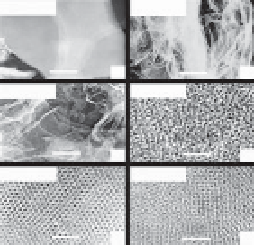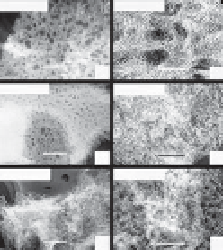Biomedical Engineering Reference
In-Depth Information
(278,200,2)
(27,386,67)
Multi-lamellar fragments
MCM-48 slices
MCM-41 particles
Single-phase region
Bi-phase region
Experimental point
Spherical morphology
Bi-continuous
Emulsion vesicles
Slices
Diethyl
ether, (y)
150 nm
(
a
)
50 nm
(
b
)
y = 456 ml
(14,432,34)
(80,200,200)
(80,200,200)
(26,370,64)
250 nm
50 nm
(
a
)
(278,200,2) (180,200,100)
(70,240,170)
(80,200,200)
90 nm
40 nm
(
c
)
(
d
)
II. y = 200 ml
(260,20,200)
Figure 12.5
(80,200,200)
(35,360,85)
y = 33.6 ml
(240,40,200)
(260,20,200)
Water (x)
Aqueous ammonia (z)
Water %
145 nm
125 nm
(
a
)
(
b
)
Figure 12.1
(70,240,170)
(80,200,200)
175 nm
(
b
)
930 nm
120 nm
(
c
)
100 nm
(
d
)
Figure 12.3
Figure 12.6
(278,200,2)
(278,200,2)
(240,40,200)
(230,50,200)
(14,432,34)
(14,432,34)
200 nm
60 nm
260 nm
860 nm
(
a
)
(
b
)
125 nm
(
a
)
72 nm
(
a
)
(
b
)
(
b
)
(230,200,50)
(230,200,50)
(230,200,50)
(23,400,57)
(23,400,57)
(230,200,50)
280 nm
240 nm
60 nm
135 nm
45 nm
230 nm
(
c
)
(
c
)
(
d
)
(
c
)
(
d
)
(
d
)
(80,200,200)
(80,200,200)
(180,200,100)
(180,200,100)
(240,40,200)
(240,40,200)
50 nm
50 nm
250 nm
200 nm
(
e
)
120 nm
60 nm
(
e
)
(
f
)
(
f
)
(
e
)
(
f
)
Figure 12.2
Figure 12.4
Figure 12.7
Figure 13.12
(Figure 12.1) The phase diagram of reaction: products obtained
at varying reaction ratios of diethyl ether:water:aqueous ammonia. The points
marked in the diagram represent the volumes of H
2
O, C
2
H
5
OC
2
H
5
, NH
3
Æ H
2
O
(as x,y, z) of the initial experiments. Five typical structural features of multi-
lamellar silica fragments examined by HRTEM formed at the indicated reaction
ratios are shown between the brackets. (Figure 12.2) Highly ordered silica slices
(MCM-48); (Figure 12.3) Regular particle-like (MCM-41) silicas; (Figure 12.4)
multi-lamellar silica fragments; (Figure 12.5) spherical particles; (Figure 12.6)
vesicle-like silicas; (Figure 12.7) bi-continuously emulsified silicas. (Reprinted
with permission from [65])
MCM-48, or MCM-41), the radiolarian-like silica sphere as well as spheri-
cal mesoporous silica with hollow inner, slices, the fragments with lamel-
lar mesostructure, and bicontinuous mesostructure [60].
13.4.2.3 Alcohol-Water System
Monodispersed silica spheres with uniform size are widely applied to
fi elds including catalysts, bioseparation, and drug delivery, as well as
high-performance liquid chromatography (HPLC) [66-70]. In 1998 Grün
and Unger prepared mesoporous silica spheres based on Stöber's method






Search WWH ::

Custom Search